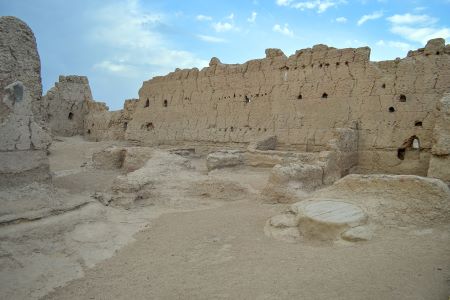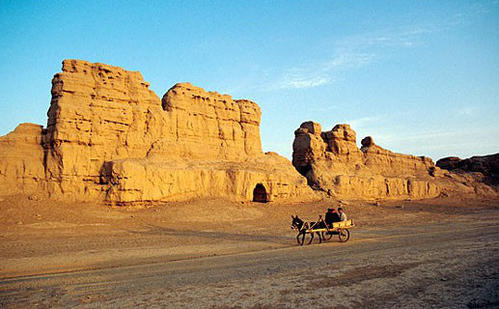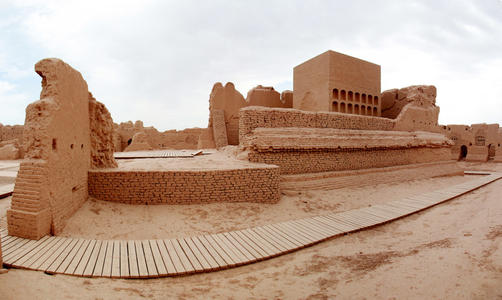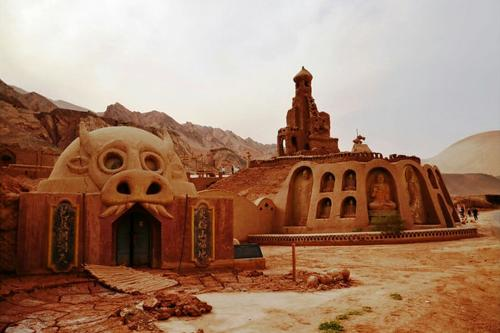Chinese Name: 高昌故城 Pronunciation: Gāochāng Gùchéng
Area: About 2 square kilometers
Admission Ticket Fare: Free
Opening Hours:10:00-19:30
Suggested Visiting Hours: 3-4 Hours
Best Visiting Time: August, September and October
Address: Sanbao Township, Gaochang District, Turpan, Xinjiang Uygur Autonomous Region

Gaochang Ancient City, known as Yiduhu City in Uyghur language which means “king city”, was named as it was the capital of the Uighur Kingdom of Gaochang. It is located 45 kilometers east of Turpan, near the Flaming Mountains. It was an important gateway to the old Silk Road and a super city among the ancient cities of the Western Region.
Gaochang Ancient City was built in the Han Dynasty(202BC-220BC). It was named for its “spacious terrain and prosperous city”. Since the Han Dynasty, Gaochang Ancient City has been a hub connecting China, Central Asia and Europe. Religions from all over the world have been introduced to the Central Plains through Gaochang. Gaochang could be said that it was the most active and advanced place of ancient religions in the world at that time. Gaochang Ancient City is one of the treasured places where the world’s religious cultures gather. In 1961, Gaochang Ancient City became the first batch of national key cultural relic protection units.
Gaochang Ancient City includes three major parts: the outer city, the inner city and Khan Fort. There are a large number of religious architectural sites and palace sites in the city ruins. There are Manichean murals, Buddhist murals and statues in the temple ruins. The city is rich in historical and cultural relics, with unearthed documents and classics in different languages. Khan Fort is in the northernmost part and there are two temple ruins preserved in the southwest and southeast corners of the outer city. Gaochang Ancient City was abandoned during the war at the end of the 13th century and most of the buildings were ruined.
In the Western Han Dynasty (1st century BC), Gaochang Ancient City laid a foundation and was built by the troops of the Western Han Dynasty. Then Han, Wei and Jin dynasties all sent officers to govern this city successively.
In 327 AD, Zhang Jun of the Former Liang Dynasty(318-376) set up counties in the Gaochang Ancient City. Then Gaochang Ancient City was under the jurisdiction of the Former Qin Dynasty(350-394), Later Liang Dynasty(386-403), Northern Liang Dynasty(397-460) and Western Liang Dynasty(400-421).
In 442AD, the remaining forces of the Northern Liang Dynasty established an exile regime in the Gaochang Ancient City.
In 450 AD, the political, economic and cultural center of Turpan Basin was completely transferred from Jiaohe City to Gaochang City.
In 460 AD, Rouran troops killed the king of Northern Liang Dynasty. After that, Zhang clan, Ma clan and Ju clan ruled Gaochang Ancient City successively. Among them, the Ju family ruled Gaochang for the longest time, reaching more than 140 years.
In 640 AD, Hou Junji, one general of Tang Dynasty, led an army to retake Gaochang Ancient City.
At the end of the 8th century, people from the ancient Tibetan regime occupied Gaochang for a time.
In the middle of the 9th century, some of the Uighur people who had migrated westward conquered Gaochang and established the Uighur Gaochang kingdom.
In 1209 A.D., the king of the Uighur Gaochang kingdom submitted to Genghis Khan, who adopted the king of Gaochang as his fifth son and married his daughter to him.
After the 13th century A.D., the Mongolian nobles in the north of the Tianshan Mountains rebelled and invaded the Uighur Gaochang kingdom several times in the south.
In 1275, the north-western Mongolian nobles in the north of the Tianshan Mountains rebelled and besieged the Gaochang Ancient City for six months, which led to the death of King of Gaochang in battle. This war lasted for over 40 years and the Gaochang Ancient City was destroyed during the war.
The existing ruins of the Gaochang Ancient City were built based on Gaochang City in the Tang Dynasty. The city is irregularly square, with a total area of about 2.2 million square meters. The city layout is similar to that of Chang’an City in the Tang Dynasty.

The structure of the outer city walls is completely intact, with some sections extremely well preserved. The outer city is 5.4 kilometers in circumference, with a wall base 12 meters thick and 11.5 meters high. There are two or three gates on each side. The most well-preserved gate is the north gate on the western wall, which has a zigzagging barbican and a large number of rectangular piers, which are made from rammed earth, with layers 8 to 12 cm thick, interspersed with a small amount of adobe and with holes in the ground made during construction. The ruins of the temple can also be seen in the south-eastern and south-western parts of the outer city.
The outer city of Gaochang was built during the Ju clan’s governance period(499AD-640AD). The excavated documents can indicate that at that time the Gaochang city had an outer city and an inner city, apart from that, in the Tang dynasty, there were also barbicans.

The inner city is located in the middle of the outer city, to the south of the palace. The walls are made entirely of rammed earth. Most of the walls on the west and south sides of the inner city are still preserved, while on the east side of the inner city, only the high ground in the north-east corner and an earthen platform base in the south-east corner can be seen, and there are still some remnants of the wall base in the north center and north-west corner of the inner city. The circumference of the inner city is measured to be about 3,600 meters, which is the same as the records in the historical records. Its construction date is earlier than that of the outer city and is rectangular in plan from north to south, with the inner city mainly consisting of palace and temple buildings.

Khan Fort is the northernmost part of the Gaochang Ancient City. The northern wall of the outer city is the northern wall of Khan Fort and the northern wall of the inner city is the southern wall of Khan Fort. The plane graph of the entire Khan Fort is rectangular, with a circumference of about 700 meters. There are still several existing relics on the western wall. The east wall is completely and nothing left. Many of the tall temple foundations remaining in the palace are about 3.5 to 4 meters high and about 35-48 cm thick. It can be seen that it is a four-storey palace building site. In the Gaochang period of the Ju clan’s governance, with the construction of the outer city, the palace was moved to the north and the king lived in the south. The layout of the palace was similar to that of Chang'an city in the Sui and Tang Dynasties.

In 629 AD, in order to improve the development of Buddhism, the Buddhist monk Xuanzang of the Tang Dynasty, regardless of the risk of death and pushing aside all obstacles and difficulties, set off from Yumen Pass, via Gaochang and arrived in India along the Silk Road. The journey to India took Xuanzang 17 years.
In Gaochang, Xuanzang and the king of Gaochang--Ju Wentai became sworn brothers. Ju wentai wanted to mandate Xuanzang the Buddhist master in Gaochang, but Xuanzang insisted on going to India to seek the Buddhist doctrine. Before Xuanzang’s departure, Ju Wentai said that I will fully support your endeavor that goes to India to explore the Buddhist doctrine. My only wish is that when you return from India, please come back to GaoChang for another three years and accept our worship. Ju Wentai then sent an escort to help Xuanzang to India and prepared 24 letters and gifts to the kings of the 24 countries that Xuanzang would pass through on his journey to the west. By the time Xuanzang returned from India 17 years later, Ju Wentai had died for years and the kingdom of Gaochang had been conquered and destroyed by the Tang Dynasty. But the friendship between Xuanzang and Ju Wentai has become a great story in history.
Chinese: 请带我去高昌故城。English: Please take me to the Gaochang Ancient City.
If you go to the Gaochang Ancient City from Turpan Jiaohe Airport, it takes about 1 hour and 20 minutes (about 140 yuan).
If you go to the Gaochang Ancient City from Turpan Railway Station, it takes about 1 hour and 50 minutes (about 200 yuan).
If you go to the Gaochang Ancient City from the center of Turpan(Mercure Hotel Turpan Downtown), it takes about 60 minutes (about 100 yuan).
